Madagascar Lovebirds (Agapornis Canis) or Grey-headed Lovebird
An article by the late Jerry Fisher. Jerry inherited his love of birds from his father, who was once Curator of Birds at Edinburgh Zoo. He lived in Paignton, Devon until he passed away about five years ago. This article was first published in The Parrot Society magazine August 2020.
When I first considered acquiring Madagascars the usual comments were “I gave up on them because I never saw them – they hid in the nest box as soon as I entered the birdroom” and “I gave up on them because they produced lots of eggs but never hatched anything.” In my experience neither is true. Certainly, chicks are wild initially (not unusual) but they steady once they are two or three months old. My birds only receive nest boxes when I wish them to breed and even then do not use them as a refuge.
Anyone unfamiliar with Madagascars will immediately be struck by how small and delicate they appear compared with the commoner lovebird species. Most lovebirds take a size M ring – Madagascars take a K, smaller than a grass parakeet. They also have an inoffensive voice – both sexes twitter and chirp, hens (and chicks) also make a growling sound when in the nest box.
Having now completed eight breeding seasons with them my experiences may be of some interest. To date they have produced 137 young reared to independence – 20+ in each of the last 6 years.
I initially acquired two pairs captive bred and imported from the Continent and subsequently built up the group by exchanging youngsters with two UK breeders – plus a further two pairs from a different European source. With the addition of odd birds from other sources I now therefore have a group with good genetic diversity. Breeding results have not been significantly different across the pairs so – thus far – my management of the birds seems to suit them.
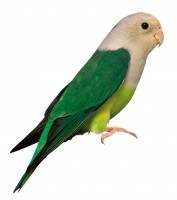

Adult cock bird; map of Madagascar, off the coast of east Africa
General Management
My birds are kept in an insulated timber and block building with no natural light. Lighting is by standard fluorescent fittings with daylight spectrum tubes for 15 hours per day. At night there are 12W nightlights, which are timed to overlap night and morning. Heating is by convector heaters with high-level fans to aid circulation. The temperature never drops below 60F and above 70F extract fans kick in – in summer the temperature can reach around 80F. The Madagascar breeding pairs are mainly housed in 3’ x 2’ x 2’ double breeders. Surprisingly, they seem to prefer the lower level units to the brightly lit “penthouses”.
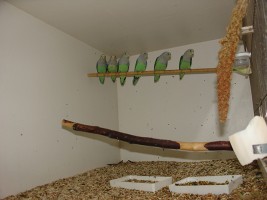
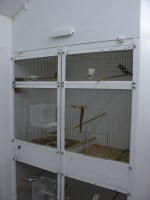
Single sex group; Breeding cages
At the end of the breeding season the young are transferred in single sex groups to 4’ x 2’ x 2’ units – no larger until they steady down. Once surplus birds have departed the remainder – adults and young – are transferred to single-sex groups in 8’ x 2’ x 2’ units. This is partly to give more exercise and partly for convenience – fewer units to maintain! I have kept pairs in their breeding units throughout the year (without nest boxes) and it has made no obvious difference to the following year’s breeding. All cages have a 1 – 2” layer of wood chips (Easibed, see appendix) on the floor – I believe in giving the birds something interesting to forage in.
Feeding
The basic diet falls into three parts:
- Dry seed mix
- Millet sprays
- Softfood mix
My standard seed mix, softfood mix and grit mix are appendices to this article.
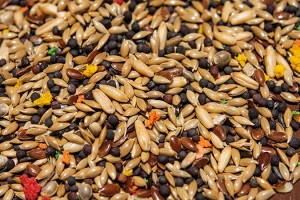
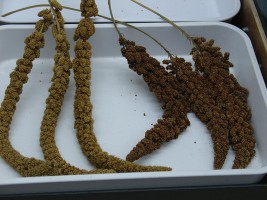
Prepared seed mix; Yellow & Red Millet Sprays
Dry Seed Mix: Offered at all times in equal parts with plain canary. Consumption varies considerably from one group/pair to another. For some of it is a significant part of their diet, others barely touch it.
Tonic seed mix is offered 2 – 3 times a week. Consumption as above.
Millet sprays: Both French red and yellow are part of the staple diet. During the breeding season red sprays are offered unlimited and are extensively used in rearing. Out side the breeding season the balance is altered to both red and yellow, gradually reducing the red until yellow are given exclusively for 2 – 3 months prior to the build-up to the next breeding season.
Softfood Mix: During the breeding season the entire mix is given fresh daily and unlimited and with red sprays forms the staple diet. This continues afterwards until the young are well established and the adults have completed their moult. Thereafter, I used to separate the sprouted seed from the rest of the mix and give the two parts on alternate days. This was reduced to a cycle of sprouted seed on day 1 and rest of mix day 3 with days 2 and 4 dry food only. All softfood was withheld for a 4 – 6 week period prior to the build-up to the breeding season. This worked well but I prepare the mix daily year-round since there is always some species going through the breeding cycle and for simplicity it is now fed daily to all my birds and they pick out of it what they want. They could certainly be tried with other green foods but the only one outwith the mix that mine showed enthusiasm for was broccoli.
Bathing water is available at all times, as are cuttlefish bone and grit mix – I find Madagascars use more of both than most of my other birds.
A word of warning – although they are used to feeding dishes on the cage floor my birds (established birds, new arrivals and newly-separated chicks) often refuse to go down to the floor to eat after being moved. They take millet sprays of course, but be prepared to offer loose seed and softfood mix in dishes hung on the cage front as well as on the cage floor for the first few days until they settle.
Breeding
Admittedly my birds are in an artificial environment, but I find that Madagascars will go down at any time of the year if they are in condition. I tend to put mine down December/January simply because it suits my own planning. Others start their birds August/October. Madagascars show no pair bonding, so as well as separating the sexes off - season fresh pairings can be made the following year to improve genetic diversity.
Once given a nest box most pairs will go down quite quickly – usually within a month. There are, of course, exceptions and I have had birds go down after three to four months – so don’t be in a hurry to write them off. I use external standard budgie boxes with an inspection lid and with a 4” x 2” wood block at the pophole end to give a 4” wide entrance step. The concave is retained and covered with about 1” of wood chips.
As mentioned earlier, my birds are only given boxes during the breeding season and I have yet to have a pair use the box as a refuge. Prior to starting breeding both birds stay out in the cage – even when I reach in to change food dishes. Once the hen has gone down a few cocks sit on guard duty inside the box but most sit on the perch at the opposite end of the cage. Again they do not enter the box even when food is changed.
In the wild Madagascar hens cut leaf strips and tuck them into their rump feathers to transport to the nest. I gave all my birds fresh twigs – usually eucalyptus, sometimes willow. Most ignored it, a few cut strips and dropped them and some pieces were taken into the box. I have only once seen a hen with strips in her rump feathers and even she didn’t bother to line the nest properly! Most hens will very quickly start entering the box and re-arrange the wood chips, sometimes throwing most of it out (which is why I retain the concaves) and others reducing it to sawdust. If they retain most of the layer they usually lay tightly in one corner of the low level.
Incubation is given as around 23 days. Judging hatching is difficult because the hens will retire to the box 7 – 10 days before they start to lay. A good indicator that laying has commenced is in the daily appearance of a much larger and softer than normal dropping on the cage floor under the perch farthest from the box.
There are exceptions. One in particular I finally forced off her eggs at 45 days expecting to find a very tired looking clutch of eggs. In fact they were clean and tidy and I hurriedly withdrew. On day 50 I heard a newly-hatched chick. She hatched and reared 4 and must have spent at least as long in the box before laying as she did incubating!
From this point the hens sit very tight – the first warning is when they hit the side of the box with their beaks, the second is a growling sound and they will attack if you persevere with opening the lid. DON’T INTERFERE!
Very soon – I guess 24-48 hours after hatching – a chick can be heard “peeping” for food. It happens seldom and for a short time, so it is easy to miss. This call only seems to last 7 – 10 days and, even though there is more than one chick in the box I have never heard more than one at a time – no competing for food as with most nestlings. From around 3 weeks if disturbed the chicks will take their cue from the hen and join in a chorus of growling to prove that the nest is really occupied by something furry with sharp teeth!
Hens show a considerable variation in the time spent in the box with the chicks after the first three weeks. The norm is to emerge occasionally and return when approached but I have had a hen which was never seen out until I finally evicted her and her chicks, while another stayed out after three weeks and only returned to feed her offspring – I initially thought she had abandoned them.
Madagascar hens really resent disturbance – checking the nest just provokes them. Once they have settled in the nest box you will seldom see them until the chicks are at least half grown. I understand the cock feeds the hen in the box and she in turn feeds the young chicks. If you wish to confirm the hen is alive draw a fingernail along the side of the box – she will respond by stage one of the warning process. The chicks emerge at around six weeks and I leave them with the parents for a further six, after which chicks and box are removed. During this time the hen will attempt a second round – which stands little chance with fledged chicks using the box as a bolt hole. I have only once had a hen hatch this second round successfully but the chicks did not survive.
It is possible to offer a fresh box for a third round after the chicks are separated. I have done this successfully but only with pairs that reared no more than two chicks in the first round simply because I think that the rearing process is so intensive for the hen (entry to chick removal around16 weeks) that one round a year is enough. Removal of the nest box can be a minor problem since the chicks (and often the hen) will continue to dive back into it for security long after they should have left. Initially I simply evicted them but have found an effective but less brutal alternative. I made up a panel of fine weldmesh which fits over the open lid of the box. Deprived of the darkness they abandon the box, which can then be removed without drama the following day.
I have yet to hear of successful colony breeding of Madagascars – possibly because of the lack of pair bonding.
Mortality and Breeding Span
It has been said that Madagascars are 1) Delicate 2) Short-lived (4 – 5 yrs) and 3) only have 2 – 3 years of fertility. I can only comment from my experience but that does not support any of the above. Including acquisitions I have records on 161 birds – I have recorded 7 deaths. Of these, one was old age and 2 were within a month of arrival in poor conditions. One was a youngster killed by its single-sex cage mates (the only instance I have had of serious aggression). The remaining 3 are unexplained.
Regarding fertility and lifespan, I had a cock arrived as adult in 2002 (hatched 2001) which died in December 2007, making him at least close to 7 years old. He had 3 mates and bred every year 2002 – 2007 inclusive except 2003 when the only available hen was too young. In total he reared 24 chicks. His first mate died on the nest in 2002 with a month old 2nd round chick, which he reared single-handed. His 3rd mate reared 2004 – 2007 inclusive and last I heard was still going strong. I gave her to a friend with an odd old cock bird.
Incidentally I have three ’09 youngsters which trace directly back to this cock, each generation being 1st year bred – making them the 8th generation over 8 years.
Fertility and Chick Losses
As will be seen from the section on “statistics” fertility varies between clutches. Usually 5 or 6 eggs are laid and some pairs are certainly more productive than others but I have had relatively few completely clear clutches. Others report chick losses during the latter stages of rearing. I have only experienced this once – when the parents stopped feeding a six week group of four chicks just as they left the nest and all four died. Otherwise my losses have all been within approximately 48 hours of hatching.
During years one and two I experienced a high level of this. It eventually dawned on me that the birds losing chicks had all been exposed to each other while the successful birds had not mixed with these. Sure enough, post mortem on a chick revealed a heavy bacterial load, including two types each of which would have been fatal. Given the age of the chick this had to be transmitted via the egg. This group were kept separate and prior to year 3 breeding season given a 7 day course of Baytril in their drinking water. I have not had this problem since. My gratitude is due to Mr Best (formerly of Vale Vets of Portishead in Bristol) for getting this result from what he said was the smallest PM examination he had ever performed!
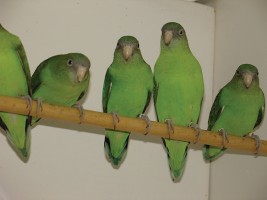
Young birds with leg rings just visible
Ringing
I never close ring any of my birds – in principle I do not disturb nests. With Madagascars this is particularly important since the hen broods and defends the chicks so intensively. I ring the chicks only when I remove them from the adults. Initially I used customised aluminium split rings as with my Mountain and Sierra parakeets. Don’t do it with Madagascars! Those that don’t remove the ring manage to close it up on the leg necessitating its urgent removal. I then tried colour – coded plastic split rings (size XB) but the incidence of removal was high. I have now solved the problem. Avian ID at Truro kindly supplied me with anodised aluminium split rings size M “shaved” to size L. These come in a wide range of colours (mine are also sequentially numbered) and are a much heavier gauge than the rings I used previously. In three breeding seasons I have not had one removal or “closing up” of a ring.
Statistics
1) The total figures for cocks and hens rather question the theory of a high ratio of cocks to hens.
2) It will be noted that, out of eight breeding seasons, three produced excess cocks, three excess hens and two equal numbers.
3) The problem is still the average chicks per nest, which remains stubbornly low. I regard 3+ as quite acceptable but the 1s and 2s pull down the average. Next year I plan to hold back some ’09 young until ’11 to see if older first breeding makes any difference. I have no reason to think it will, but “try anything”.
Conclusion
Madagascars are delightful, quiet, inoffensive little birds. I have found their reputation regarding temperament and breeding to be undeserved if you are prepared to give them a bit of time and effort.
Appendix
I have experimented quite a bit with soft and dry mixes. The notes below are the current regime which seems to have high acceptability and I have no plans to vary for the coming season.
